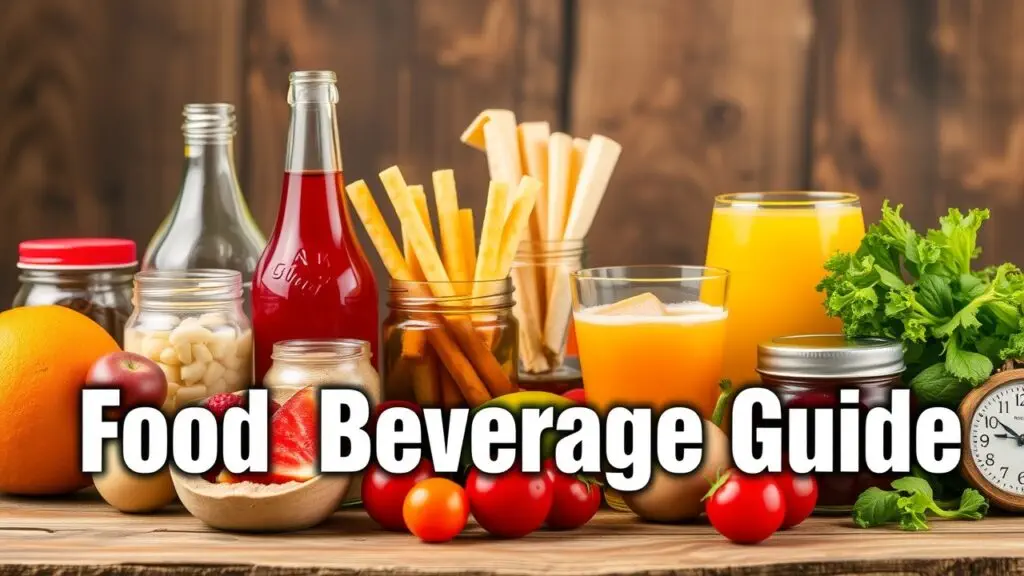This guide explores various types of food and beverages across different settings, from fast food to fine dining, covering restaurant operations and industry trends.
What Are Food and Beverages?

Food and beverages are key parts of our daily lives. Food is anything we eat for nourishment, while beverages are liquids we drink for hydration or enjoyment. Together, they contribute to our health and happiness.
Nutrition is a main function of food and drinks. They provide essential nutrients like carbohydrates, proteins, fats, vitamins, and minerals that help our bodies work well. Eating a variety of food types can lead to better health by supporting growth, healing tissues, boosting immunity, and preventing illnesses.
Food and beverages also hold cultural importance. Various cuisines around the world reflect local traditions and ingredients. Here are some examples:
- Italian: Known for pasta dishes; herbs like basil are commonly used.
- Mexican: Famous for spicy flavors; beans and corn are staples.
- Japanese: Focuses on fresh seafood; presentation is key.
- Indian: Rich in spices; many vegetarian options.
Learning about these culinary offerings helps us appreciate different cultures while exploring new tastes.
Why Categorizing Food and Beverages Matters?
Understanding food classification is important for making smart choices about our diets or planning events. By recognizing different categories—like nutritional value (macronutrients vs. micronutrients), processing levels (whole vs. processed foods), various cuisines (ethnic restaurants), or beverage types (alcoholic vs. non-alcoholic)—we can create better meal plans.
Here’s why this categorization matters:
- Nutritional Value: Foods can be grouped by their nutrients. Carbohydrates give us energy; proteins help repair muscles.
- Processing Levels: Whole foods keep most nutrients intact, while processed foods may have additives that reduce their health benefits.
- Cuisines: Trying different ethnic cuisines can introduce exciting flavors and new dishes into your diet.
Knowing how to categorize food helps improve personal eating habits by factoring in budget constraints or cultural influences when choosing meals or drinks for special occasions or daily life.
In short, understanding the types of food and beverages available gives us insight into nutrition while celebrating culinary diversity worldwide—a step toward healthier eating habits suited to personal preferences.
How Is Food Classified by Nutritional Content?
Food gets classified based on its nutritional content. This helps people understand how different foods meet their dietary needs. Knowing this is important for promoting healthy eating and a balanced diet. The main categories are macronutrients and micronutrients.
Macronutrients
Macronutrients provide energy and are needed in larger amounts. They include carbohydrates, proteins, and fats.
- Carbohydrates: These are the body’s main energy source. Foods that are high in carbohydrates include grains like rice, bread, pasta, fruits like bananas and apples, and starchy vegetables like potatoes. Carbs can be simple sugars (like glucose) or complex carbs (like whole grains).
- Proteins: Proteins are important for building muscles and fixing tissues. They come from animal sources (like meat, fish, and eggs) as well as plant sources (like beans, lentils, and nuts). Each type of protein has different amino acids that help with health.
- Fats: Fats give us a lot of energy but should be eaten carefully because they have many calories. Healthy fats can be found in foods like avocados, olive oil, nuts (like almonds), seeds (like chia), and fatty fish (like salmon). Saturated fats are often in butter or red meat.
Knowing about these macronutrient types helps people choose foods based on nutritional value.
Micronutrients
Micronutrients are vitamins and minerals that help the body but are needed in smaller amounts than macronutrients.
- Vitamins: These compounds support important body functions. For example:
- Vitamin C helps the immune system.
- B vitamins support energy production.
- Vitamin D is good for bones.
- Minerals: Minerals are necessary for things like muscle movement and nerve function. For instance, iron is found in spinach or red meat; calcium comes from dairy products to help strengthen bones; potassium is in bananas to help control fluid balance in cells.
Eating a mix of fruits and vegetables makes sure we get enough of these important micronutrients for good health.
What Is Energy Density in Foods?
Energy density means how many calories are in a certain weight or volume of food. Understanding this helps people make better choices about portion sizes without giving up nutrition quality.
For example:
| Food Type | Calories per 100g |
|---|---|
| Nuts | ~600 |
| Avocado | ~160 |
| Vegetables | ~25 |
| Fruits | ~50 |
Nuts have high energy density because they contain lots of fat—so they have more calories per gram compared to most foods. In contrast, leafy greens offer low-calorie options packed with fiber that can keep you full without too many calories.
By knowing the difference between high-energy-dense foods like nuts and lower-density options like fruits or vegetables, you can make healthier eating choices that fit your personal goals—whether that’s losing weight or just maintaining a healthy lifestyle while enjoying different types of food!
Types of Food Based on Processing Levels
What Are Whole Foods?
Whole foods are foods that are not heavily processed. They don’t have artificial ingredients, which is why they are so important for healthy eating. These foods stay close to their natural form, giving our bodies vital nutrients. Eating whole foods can lead to more energy, better digestion, and a lower chance of getting chronic diseases.
Here are some examples of whole foods:
- Fresh Fruits and Vegetables: These give you lots of vitamins, minerals, and fiber. Eating different types helps you get many nutrients.
- Nuts and Seeds: Nuts like almonds and walnuts are full of healthy fats, protein, and antioxidants. They’re great for snacking!
- Whole Grains: Foods like brown rice, quinoa, and oats provide complex carbs that fuel your body while adding fiber to your diet.
Adding these foods to your meals can make your diet much healthier.
Processed Foods: Impact on Health
Processed foods come in different forms. Some are lightly processed while others are ultra-processed. Lightly processed foods include items like canned beans or frozen veggies. They keep most of their nutrition and make cooking easier. On the other hand, ultra-processed foods often have too much sugar, salt, unhealthy fats, and artificial ingredients. Think of sugary snacks or fast-food items.
The additives in these foods can harm health when consumed in excess. Too much processed food can lead to issues like obesity and heart disease.
Knowing how these food types differ helps you choose wisely for your health goals. Balancing whole foods with an understanding of processed options is crucial for a healthy diet.
Culinary Categories Across Ingredients & Preparation Methods

Culinary Categories by Ingredient Type
Grains
Grains are a big part of diets worldwide. They fall into two main types: whole grains and refined grains. Whole grains, like brown rice, quinoa, and oats, keep their bran and germ layers. This means they have more fiber and nutrients. Refined grains have been processed to make them finer, but this can take away some nutrition. Examples of refined grains include white rice and white bread. Mixing whole and refined grains in meals adds variety and provides essential carbohydrates.
Legumes
Legumes are super healthy! They include lentils, chickpeas, beans, and peas. These foods are packed with protein and fiber. They’re also very versatile; you can use them in many dishes from hummus to soups. Eating legumes is great for heart health since they are low in fat and full of vitamins.
Vegetables
Vegetables come in different types: leafy greens (like spinach), root veggies (like carrots), and cruciferous vegetables (like broccoli). Each type offers unique flavors and important vitamins. Leafy greens are great for iron while cruciferous veggies may help reduce cancer risk due to special compounds.
Fruits
Fruits bring natural sweetness to meals while providing important nutrients such as vitamin C and antioxidants. You can find fruits in categories like tropical fruits (like mangoes), berries (like strawberries), and citrus fruits (like oranges). Eating a mix of fruits not only makes meals tastier but also boosts overall health.
Dairy Products & Alternatives
Dairy products include milk, cheese, and yogurt that give us calcium for strong bones. But there are also alternatives like almond milk or tofu cheese for people who want plant-based options or who can’t have dairy. Knowing the differences between these choices helps people meet their dietary needs without losing flavor.
Protein Sources
Protein sources vary widely across diets. Meat options include poultry like chicken or fish which provide all essential amino acids our bodies need. Vegetarian sources like nuts and seeds also offer protein along with healthy fats, making them great additions to any meal! Balancing protein sources ensures everyone gets enough nutrients.
Culinary Categories by Preparation Method
Your Cooking Methods Matter!
How you cook food changes its flavor and nutrition! Here’s how:
- Baking keeps moisture in foods which is often healthier than frying.
- Frying uses oils that add extra calories.
- Roasting brings out natural sweetness in vegetables by caramelizing sugars.
- Steaming is better than boiling since it preserves more nutrients by using less water.
Understanding how different cultures use these cooking methods lets us appreciate global culinary traditions more!
Non-Alcoholic Beverages
Non-alcoholic beverages are drinks that don’t have alcohol. This group includes a lot of options, like refreshing waters, tasty juices, and hot drinks like coffee and tea. Knowing about these categories helps you choose the best drinks for hydration and taste.
Water Types
Water is super important for our health. There are different types to choose from:
- Tap Water: This is what comes from your sink. It’s treated by local governments, so it’s safe to drink, but its taste can change based on where you live.
- Bottled Water: Many people like this for convenience. Bottled water can come from springs or regular tap sources. Always check the label to make sure it’s good quality.
- Mineral Water: This type comes from natural springs and has minerals like calcium or magnesium. These minerals can be good for you, and they change how the water tastes.
Knowing these differences can help you pick the right kind of water based on what you like and what’s healthy.
Juices
Juices are a fun way to enjoy fruit while getting vitamins; still, they have ups and downs:
- Pros: Fresh fruit juices are packed with vitamins, especially vitamin C, and antioxidants that can boost your health.
- Cons: Many store-bought juices have added sugars, which can mean extra calories without the fiber you’d get from whole fruits. It’s smart to read labels before buying.
Choosing juices that are 100% fruit with no added sugars is a good way to keep it healthy.
Coffee and Tea
Coffee and tea are popular hot drinks around the globe, each with its special taste:
- Both have caffeine, but coffee usually has more than tea.
- These drinks may also offer health benefits; studies show that drinking them in moderation could lower the risk of some diseases because of their antioxidants.
When choosing your drink, think about how much caffeine you want along with any specific flavors you enjoy.
Alcoholic Beverages
Alcoholic beverages contain ethanol (the type of alcohol safe for people). They come in different types: beer, wine, spirits, and cocktails:
- Beer Styles: Beer mainly falls into two kinds: lagers (which ferment in cooler conditions) and ales (fermented at warmer temperatures). Each style brings unique tastes—ranging from light pilsners to dark stouts.
- Wine Types: Wines are usually split into red or white based on the grapes used. Red wines often have stronger flavors while whites are lighter; both types pair well with different foods to enhance meals.
- Spirits & Cocktails: Spirits such as vodka or whiskey form the base for many cocktails—a mix designed for varied flavors suited for social occasions.
Always practice responsible drinking when enjoying alcoholic beverages—knowing your limits helps make gatherings enjoyable while keeping everyone safe.
Dietary Needs and Restrictions
Dietary needs and restrictions are super important for people when they choose their food. Knowing about these things can help anyone interested in nutrition, like cooks, students, or event planners.
Allergies
Food allergies can be really serious. Some common ones are nuts, dairy, and shellfish. Being aware of these allergies is key when eating out. Restaurants usually show allergen info on menus so customers can make safe choices.
Intolerances
It’s crucial to know the difference between allergies and intolerances. An allergy makes your immune system react and can be life-threatening. Intolerances usually cause stomach issues but don’t involve the immune system. For example, lactose intolerance means your body can’t handle lactose from dairy, which causes discomfort. Gluten sensitivity affects people who react badly to gluten in foods like bread.
Specific Diets
More people are choosing specific diets these days. Veganism avoids all animal products, while vegetarianism allows some, like eggs or dairy but not meat. Both diets focus on plant-based foods, which are getting more popular thanks to new alternatives, like almond milk instead of cow’s milk or veggie burgers instead of beef patties.
Health Goals
Health goals affect what people eat by guiding them to healthier options that boost well-being.
Supporting Weight Management
Different foods impact calorie intake in various ways. High-fiber foods make you feel full while having fewer calories compared to junk food that’s loaded with sugars and fats. Drinks also matter; sugary drinks add a lot to daily calories without any real nutrition.
Disease Prevention
Eating balanced meals filled with fruits, veggies, whole grains, lean proteins, and healthy fats helps prevent chronic diseases. This kind of eating not only helps manage weight but also lowers risks for issues like heart disease and diabetes.
Personal Preferences and Enjoyment
People’s tastes play a huge role in what they eat beyond just health reasons; enjoying food matters too.
Balancing Healthy Eating with Personal Tastes
When planning meals, people often juggle healthy eating with what they enjoy. Flavor profiles—like sweet or savory—can greatly influence daily food choices while still aiming for nutrition balance.
Budget and Accessibility
Budget plays a big role in what people choose to eat when they want quality ingredients at fair prices and consider availability of local versus imported items.
Influences on Food Choices
Money impacts decisions about which foods to buy based on what’s available nearby and how much it costs from suppliers. This affects everything from fresh produce markets to grocery stores that sell packaged foods across the country.
Cultural Considerations
Cultural identity shapes what people prefer to eat around the world. Traditional dishes carry meaning that reflects values passed down through generations.
The Role of Culture in Food Selection
Looking at cultural influences shows how traditions guide cooking styles within families, leading them toward certain flavors and textures unique to their backgrounds. This fosters appreciation among diners eager for genuine representations from different regions globally during communal meals celebrating diversity.
Best Practices

Reading Food Labels
Reading food labels is key for smart eating choices. Food labeling shows important nutritional information. You can find calorie counts, serving sizes, and ingredient lists on labels. Knowing this helps you meet your dietary needs and follow food safety regulations. When shopping, check that whole ingredients are listed first; this usually means a healthier choice. Also, look for allergens or additives that might affect your health.
Prioritizing Whole, Unprocessed Foods
Picking whole foods over processed ones is super important for healthy eating. Whole foods are close to their natural form, like fruits, veggies, nuts, seeds, whole grains, and lean proteins. They pack more nutrients compared to processed foods, which often have added sugars and unhealthy fats. To boost your nutrition, add more unprocessed foods to your meals. They provide essential vitamins and minerals needed for good health.
Limiting Sugary Drinks and Processed Foods
Sugary drinks can add a lot of calories without many nutrients. Reducing these drinks—like sodas and sweetened teas—can help you reach your health goals. This could be weight management or lowering the risk of diseases like diabetes. Also, cutting down on processed foods helps you avoid unnecessary additives that can mess with diet management.
Staying Hydrated
Staying hydrated matters for overall well-being; drinking enough water is key every day. Non-alcoholic beverages such as herbal teas or infused waters can also help keep you hydrated while adding some flavor without the added sugars found in many sodas or juices.
Global Perspectives on Food and Beverage Culture
Food and beverage culture changes a lot around the world. Different places have their own styles based on geography, climate, history, and cultural identity. When we learn about these differences, we can enjoy diverse culinary traditions even more.
Regional Variations in Cuisine and Dietary Habits
Regional food shows local ingredients and cooking methods. It also reflects dietary needs shaped by cultural identity. Here are some examples:
- Mediterranean Cuisine: This style focuses on fresh veggies, olive oil, fish, and whole grains.
- Asian Cuisine: Rice is a staple here, mixed with various spices; soy sauce and curry are common.
- Latin American Cuisine: Think of beans, corn tortillas, and meats like chicken or beef.
Ethnic restaurants help highlight these regional variations. They let us taste authentic flavors while meeting different dietary needs, such as vegetarian or gluten-free options.
Exploring Diverse Culinary Traditions
The world has many types of cuisine with unique culinary offerings. Each area boasts its own gastronomy that features specific ingredients and cooking styles:
- Italian Cuisine: Famous for pasta dishes like spaghetti carbonara or lasagna.
- Indian Cuisine: Known for its rich spices; popular dishes include biryani and butter chicken.
- Japanese Cuisine: Celebrated for sushi and ramen; this cuisine uses seasonal ingredients a lot.
These culinary traditions do more than fill our stomachs; they reflect the cultural backgrounds of their regions.
The Impact of Globalization on Food and Beverage Consumption
Globalization has changed the global food industry by shifting consumer preferences. Now people can easily access international cuisines. For example, many restaurant menus offer fusion foods that mix elements from different cultures—like Korean tacos or sushi burritos—that attract adventurous eaters.
Also, globalization influences how we enjoy drinks; coffee shops now feature specialty beverages inspired by worldwide trends rather than just sticking to traditional options.
Food and Beverage Trends
Recent innovations in food show changing tastes among consumers:
- Plant-based diets are getting more popular as people focus on health.
- Ethnic flavors are becoming standard as folks search for authentic meals.
- Sustainable practices are important in both food sourcing and production methods.
These trends reflect how society’s values change when it comes to what we eat.
Sustainability in Food and Beverage Production:
Sustainability is key in today’s food systems because more people care about ethical sourcing that lowers environmental harm. Key areas include:
| Aspect | Description |
|---|---|
| Ethical Sourcing | Focusing on suppliers who use fair trade |
| Water Usage | Using efficient irrigation methods |
| Waste Reduction | Reducing waste throughout production cycles |
By supporting sustainability efforts in the global food industry—like organic farming—we can help maintain healthier ecosystems while enjoying diverse culinary experiences from everywhere.
FAQs About Types of Food and Beverages
What are the main categories of food?
Food can be categorized into several main groups. These include grains, vegetables, fruits, proteins, and dairy products. Each group offers unique nutrients and health benefits.
How are beverages classified?
Beverages are classified into non-alcoholic and alcoholic types. Non-alcoholic options include water, juices, coffee, and tea. Alcoholic beverages cover beer, wine, spirits, and cocktails.
What examples illustrate different cuisines?
Cuisines vary globally. Italian cuisine features pasta dishes, while Indian cuisine is known for its rich spices. Mexican cuisine often includes beans and corn, highlighting regional ingredients.
What are types of alcoholic and non-alcoholic beverages?
Non-alcoholic drinks include soft drinks, herbal teas, fruit juices, and flavored waters. Alcoholic drinks encompass beers like lagers or ales, wines (red or white), and spirits such as vodka or whiskey.
How can food be categorized based on nutritional value?
Food classification focuses on macronutrients (carbohydrates, proteins, fats) and micronutrients (vitamins and minerals). This helps individuals choose foods that align with their dietary needs.
Additional Insights on Food and Beverage Trends
- Types of Restaurants: Quick Service Restaurants (QSRs) serve fast meals. Full-Service Restaurants offer complete dining experiences. Casual dining provides a relaxed atmosphere for families.
- Event Planning: Banqueting services cater to events like weddings and conferences. They provide tailored menus to suit diverse preferences.
- Culinary Offerings: Ethnic cuisines introduce various flavors through specific ingredients. They reflect cultural identities through traditional dishes.
- Dietary Needs: Understanding allergies is crucial in food selection. People must consider dietary restrictions when planning meals.
- Food Safety Regulations: Compliance ensures safe food handling practices across all food service establishments.
- Sustainability Practices: Businesses adopt eco-friendly practices in sourcing ingredients to promote healthier ecosystems.
- Restaurant Technology: Point of Sale systems streamline operations. Online ordering systems enhance customer convenience for takeout services.
These insights provide a comprehensive look into the diverse landscape of food and beverages while considering consumer preferences.
Related Topics
- Types of Cuisines
- Types of Macronutrients
- Types of Micronutrients
- Types of Processed Foods
- Types of Whole Foods
- Types of Water
- Types of Juices
- Types of Coffee and Tea
- Types of Beer
- Types of Wine
- Types of Spirits
- Types of Cocktails
- Types of Food Allergies
- Types of Food Intolerances
- Types of Diets
- Types of Restaurants
- Types of Event Planning Services
- Types of Culinary Offerings
- Types of Dietary Needs
- Types of Food Safety Regulations
- Types of Sustainability Practices
- Types of Restaurant Technology



Types of Food and Beverages: A Complete Guide